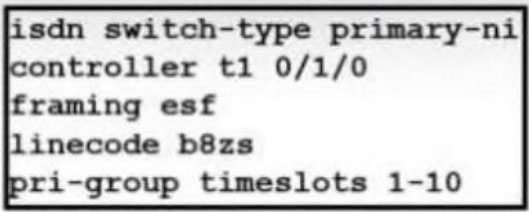


Refer to the exhibit. An engineer configures ISDN on a voice gateway. The provider confirms that the PRI is configured with 10 channels the engineer ordered and is working from the provider side, but the engineer cannot get a B-channel to carry voice. The rest of the configuration for the serial interface and voice network is functioning correctly. Which actions must be taken to carry voice?
JC2008
Highly Voted 2 years, 3 months agosneff91
1 year, 3 months agoMeowthL
2 years, 3 months agoG0y0
Most Recent 3 months, 2 weeks agoG0y0
3 months, 2 weeks agodecdca7
7 months agoKomy
1 year, 1 month agoTestme1235
2 years, 3 months agoG0y0
3 months, 2 weeks agoWeNt48
2 years, 3 months agoG0y0
3 months, 2 weeks agom4tt30000
2 years, 3 months ago0n3
1 year, 5 months agosneff91
1 year, 3 months ago